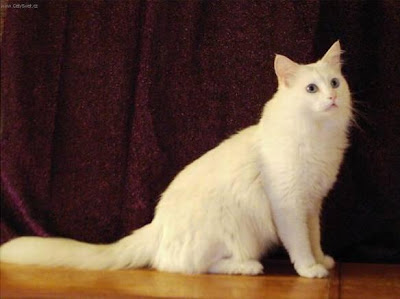Th e Turkish Angora and Van cats are ancient breeds that were developed in the distinct geographical regions of Turkey from which they derive their names. Th e Turkish Angora cat is known to get its name from Ankara (formerly known as Angora), the capital city of Turkey. Ankara is also known as the home of Angora rabbits and goats, which have finely textured, silky long coats.
The Turkish Van cat, which likes swimming, has existed in the Lake Van region of eastern Turkey for thousands of years. Th e Turkish Van can have gold, blue, or odd eyes. Th e eyes of the Turkish Angora can also be any variety of blue, gold, or odd. Th e majority of Angora cats (over 90%) with blue eyes and some odd-eyed cats are born deaf, while deafness is less common (2%-3%) in Van cats (9,10). Both cats have fur with no undercoat or are described as singlecoated.
The Turkish cats are similar to each other and there has been debate about their origins. It was suggested that the Turkish Van is a white, gray, and red tabby variety of the Turkish Angora in eastern Turkey. In contrast, Güre suggested that the Turkish Angora cat might be a variety of the Turkish Van cat. Arikan et al. reported that the origins of the Turkish Angora and Van cats might have been the similar due to the high prevalence of type B blood in both pedigreed cats. Both the Turkish Van and Angora cats are known and treasured for their solid white color in Turkey.
If these cats have diff erent colors other than white, most Turkish people are reluctant or hesitant to call these cats Turkish Van or Angora cats. Odd-eyed cats are even more treasured among Turkish Van cats in Turkey. Helgren observed that the preferred look for the Turkish Van is a glistening chalk-white body with colored patches confi ned to the head and tail, also known as “the Van Pattern.”
The scientific data published on these 2 cat breeds are very limited and little is known about some specifi c characters of these cats, such as hair characters. Th is could be partly due to the fact that the numbers of Turkish Van and Angora cats are limited, even in their home country. Recent works described some of the body characteristics and biochemical parameters of the Turkish cats, but more research needs to be done in order to better understand and prevent confusion about these invaluable cats. Th erefore, in this study, we primarily aimed to determine the hair characteristics of Turkish Angora and Van cats, and we also investigated possible seasonal, sex, age, and eye color eff ects on the hair characteristics of these pedigreed Turkish cats.
The Turkish Angora is a medium to small sized cat, long and svelte with all the features combining in balance to give an impression of graceful, flowing motion. A breed that is inquisitive and active, they respond best to firm handling. When being judged, they should be taken stretched from the cage.
Head: A modified wedge in shape. Small to medium in proportion to the body. Top of the skull is medium wide, flat and long, with a smooth taper to the chin. No pinch at the whiskers. Allowance to be made for stud jowls on males. Nose to be medium long with no break, gentle slope allowed. Chin to be firm, gently rounded, tip perpendicular to the nose. The neck is slim and graceful and medium in length. Ears: Wide at base, tall, pointed and tufted. Set high on head and erect. Eyes: Large, almond shaped. Slanting upward slightly. Eye Color: Amber. Slight green casting allowed. Exception: Blue or Odd Eyed accepted in Whites and Green is required in Silver Tabbies.
Body: Medium to small in females, allowance to be made for slightly larger males. Torso should be long with back legs slightly higher than front legs. Boning should be proportionate to the size of the cat. Legs: Upper leg should lie at close angle to the body with the lower leg straight. Feet: Paws should be evenly rounded in proportion to the body with long tufts of hair between toes. Tail: Long and wide at the base, tapering narrowly towards the tip. Tail should be carried lower than body but not trailing. When moving, tail is sometimes carried as a “plume” over the body.
Coat: Should be longer on the ruff and undersides, back legs full. Coat texture should be silky and fine with a silk-like sheen. Full brush on tail. Wavy on stomach. Seasonal variations in coat are acceptable.
Color: Color spot on whites is allowable up to two years of age.
Condition: Slim, firm. Neither fat nor emaciated.
Balance: Proportionate in all physical aspects with graceful, lithe appearance. Amenable to handling. The Turkish Angora is not fully mature until two years of age. Consideration should be given to young adults.














0 comments:
Post a Comment